Rover SD1
| Rover SD1 | |
|---|---|
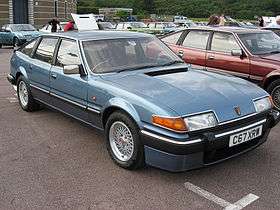 | |
| Overview | |
| Manufacturer |
British Leyland (Rover marque) |
| Also called | Standard 2000 |
| Production |
1976–86 303,345 produced |
| Assembly |
Castle Bromwich, England Cowley, Oxford, England Solihull, West Midlands, England Chennai, India New Zealand[1] |
| Designer | David Bache & Spen King |
| Body and chassis | |
| Class | Executive car (E) |
| Body style | 5-door liftback |
| Layout | Front-engine, rear-wheel-drive |
| Powertrain | |
| Engine | |
| Transmission |
3-speed automatic 5-speed manual |
| Chronology | |
| Predecessor |
Rover P6 Triumph 2000 |
| Successor | Rover 800 |
Rover SD1 is both the code name and eventual production name given to a series of executive cars built by British Leyland (BL), under the Rover marque. It was produced through its Specialist, Rover Triumph and Austin Rover divisions from 1976 until 1986, when it was replaced by the Rover 800. The SD1 was marketed under various names. In 1977 it won the European Car of the Year title.[2]
In "SD1", the "SD" refers to "Specialist Division" and "1" is the first car to come from the in-house design team.
The SD1 can be considered as the last British Rover, being the final Rover-badged vehicle to be produced at Solihull, as well as being the last to be designed largely by ex-Rover Company engineers. Future Rovers would be built at the former British Motor Corporation factories at Longbridge and Cowley; and were to rely largely on Honda engineering.
History
Background

In 1971, Rover, at that time a part of the British Leyland (BL) group, began developing a new car to replace both the Rover P6 and the Triumph 2000/2500. The designers of both Triumph and Rover submitted plans for the new car, of which the latter was chosen. David Bache was to head the design team, inspired by exotic machinery such as the Ferrari Daytona and the late 1960s design study by Pininfarina for the BMC 1800, which also guided the design of the Citroën CX. Spen King was responsible for the engineering. The two had previously collaborated on the Range Rover. The project was first code-named RT1 (for Rover Triumph Number 1) but then soon changed to SD1 (for Specialist Division Number 1) as Rover and Triumph were put in the new "Specialist Division" of British Leyland.
Design
The new car was designed with simplicity of manufacture in mind in contrast to the P6, the design of which was rather complicated in areas such as the De Dion-type rear suspension. The SD1 used a well-known live rear axle instead. This different approach was chosen because surveys showed that although the automotive press was impressed by sophisticated and revolutionary designs the general buying public was not, unless the results were good. However, with the live rear axle came another retrograde step – the car was fitted with drum brakes at the rear.
Rover's plans to use its then fairly new 2.2 L four-cylinder engine were soon abandoned as BL management ruled that substantially redesigned versions of Triumph's six-cylinder engine were to power the car instead. The Rover V8 engine was fitted in the engine bay. The three-speed automatic gearbox was the BorgWarner 65 model.
The dashboard of the SD1 features an air vent, unusually, directly facing the passenger. The display binnacle sits on top of the dashboard in front of the driver to aid production in left-hand drive markets, since it avoided the expense of producing two different dashboard mouldings for LHD and RHD versions. The air vent doubles as a passage for the steering-wheel column, and the "podular" display binnacle can be easily fitted on top of the dashboard on either the left or right-hand side of the car.[3][4] This concept was not entirely new; it had also been used on the Range Rover and was used again on the Mk.1 Austin Metro, both of which were also designed by David Bache.
An estate body had been envisaged, but it did not get beyond the prototype stage. Two similarly specified estates have survived, and are exhibited at the Heritage Motor Centre and the Haynes International Motor Museum respectively. One was used by BL chairman Sir Michael Edwardes as personal transport in the late 1970s. The two cars as befit prototypes differ in the detail of and around the tailgate. One car has a recessed tailgate, while the other has a clamshell arrangement, where the whole tailgate is visible when closed.
The SD1 was intended to be produced in a state-of-the-art extension to Rover's historic Solihull factory alongside the TR7. It was largely funded by the British government, who had bailed BL out from bankruptcy in 1975. Unfortunately this did nothing to improve the patchy build quality that then plagued all of British Leyland. That, along with quick-wearing interior materials and poor detailing ensured that initial enthusiasm soon turned to disappointment.
Initial model and first additions to range
This car was launched on its home market in June 1976 in liftback form only, as the V8-engined Rover 3500: SOHC 2.3 L and 2.6 L sixes followed a year later, when the P6 range was finally discontinued. Although there was no four-cylinder version of the SD1 at this point, British Leyland produced 1.8, 2.0 and 2.2 versions of the smaller Princess in order to compete with the entry-level versions of the Ford Granada, as well as more expensive versions of the Ford Cortina.
The car was warmly received by the press and even received the European Car of the Year award for 1977. Its launch on the European mainland coincided with its appearance at the Geneva Motor Show in March 1977, some three months after the Car of the Year announcement. Dealers had no left-hand drive cars for sale, however, since production had been blocked by a tool makers' strike affecting several British Leyland plants and a "bodyshell dispute" at the company's Castle Bromwich plant.[5] Closer to home, the car and its design team received The Midlander of the Year Award for 1976, because they had between them done most in the year to increase the prestige of the (English) Midlands region.[6]
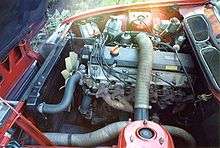
Poor construction quality was apparent even in the company's press department fleet. The British magazine Motor published a road test of an automatic 3500 in January 1977, and while keen to highlight the Rover's general excellence, they also reported that the test car suffered from poor door seals, with daylight visible from inside past the rear door window frame's edge on the left side of the car, and a curious steering vibration at speed which might (or might not) have resulted from the car's front wheels not having been correctly balanced.[7] Disappointment was recorded that the ventilation outlet directly in front of the driver appeared to be blocked, delivering barely a breeze even when fully open; the writer had encountered this problem on one other Rover 3500, although he had also driven other cars of the same type with an abundant output of fresh air through the vent in question.[7] Nevertheless, in March 1977, Britain's Autocar was able to publish an article by Raymond Mays – a famous racing driver and team manager during (in particular) the 1930s, 1950s and 1960s – in which Mays explained why, after driving it for 12,000 miles, he considered his Rover 3500 was "the best car he [had] ever had", both for its many qualities as a driver's car and for its excellent fuel economy even when driven hard.[8] Similar ventilation problems persisted until 1980 and were reported in tests of the V8-S version.[9]
Another area of concern was flaking paint on early models, forcing British Leyland to spend lots on repainting cars.[10]
In television shows John Steed in The New Avengers and George Cowley in The Professionals both used yellow Rover 3500 models. Although using different registration numbers both were possibly the same car.
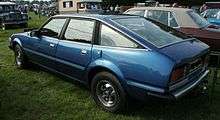
Cosmetic tweaks and range expansion
Between 1976 and 1981 there were some very minor updates to the car including new badging (front and rear) and chrome backed door mirrors. Mid-1979 saw the introduction of the then range topping V8-S model with no mechanical alterations, available in a rather bright metallic "Triton" green amongst others with either gold or silver-painted alloy wheels depending on the body colour. Interior specification included air-conditioning, thick luxurious carpets,[9] velour seats and a headlamp wash/wipe system. This now very rare model was replaced in late 1980 with the Vanden Plas (VDP) model, which came with a leather interior as standard.
United States

In 1980 Rover obtained US type approval for the SD1 and re-entered the American market after a ten-year absence. The car was only made available as a single variant, using a modified version of the V8 engine and badged simply as "Rover 3500".[11] The equipment and trim levels were similar to that of the UK market's then top-of-the-range V8-S model. The main differences were a smaller steering wheel, the sunroof (moonroof) being a cost option and rear passenger head restraints were not available at all. Small Union Jack decals were fixed to the lower section of each front wing, just ahead of the doors, to promote the car's British origins. The five-speed manual gearbox was supplied as standard, with the three-speed automatic version being a cost option.[12]
US safety legislation (that first applied to the Citroën DS) demanded that the headlamp arrangement excluded the front glass panels. Also larger, heavier bumpers were required, increasing the overall length to 191 inches (4850 mm).
American emissions regulations necessitated other differences including replacement of the carburettors with Lucas' L-Jetronic fuel injection system and the fitting of dual catalytic converters, a modified exhaust manifold and de-smogging equipment. The engine's compression ratio was modified to 8.13:1. Publicity material claimed it was capable of reaching 148 hp (SAE) at 5100 rpm[13] but the car as sold actually peaked at 133 hp (at 5000 rpm).[14][15] A desmogged carburetted engine had already been on sale in Australia since August 1978, with 102 kW (137 hp). Australia received a version of the fuel injected federalized engine with 106 kW (142 hp) beginning with the 1981 model year.[16]
Despite the necessary modifications, Rover chose not to set up an assembly plant in the US but built and shipped the cars from the Solihull factory.
The SD1 gained positive reviews in the American press and was competitively priced against rivals such as the BMW 5-Series and corresponding Mercedes-Benzes.[17] Nevertheless, the car achieved just 480 sales between its launch in June 1980 and the end of that year. The whole of 1981 attracted 774 sales, although most of these cars had actually been built and stockpiled the previous year.
.jpg)
Rover ceased the supply of American market SD1s at the end of 1981, although unsold cars remained available from dealers well into the following year.
Reasons for the commercial failure of the SD1 in the US are open to speculation. The weak value of the American dollar against European currencies at the time rendered imports relatively expensive in comparison to home-built product. A significant rise in oil prices during 1979 led to many motorists opting for more fuel-efficient cars. Public awareness of the SD1 may have been low as the dealership network across America was small, while Rover's expenditure on the aforementioned modifications, testing and approval for the US market left limited budget for publicity and advertising. (To save money the official press launch was combined with that of the Triumph TR8.)[18]
Production shift
Major restructuring of BL following the Ryder Report resulted in the SD1 production line being moved to the former Morris plant in Cowley in 1981. The Solihull plant was turned over to produce Land Rover models, following on from that marque's separation from Rover in 1978. The hugely expensive extension to Solihull, which had been built specifically for the SD1 and Triumph TR7, was mothballed, and was finally brought back into use in 1997 for the Land Rover Freelander and in 2016 for the Jaguar XE and F-PACE.
1981 also saw the beginning of "Project XX" – a venture between BL and Honda for a new executive car expected to replace the SD1, although it was not anticipated for production until the mid 1980s. Project XX ultimately emerged as the Rover 800 Series in 1986 and would be the replacement for the SD1.
Major mid-life facelift
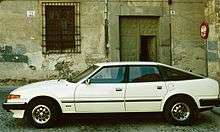
Early in 1982, Rover unveiled the Cowley-built, facelifted line to the public. These cars benefited mostly from small cosmetic changes on the exterior as well as a quite extensively redesigned interior. Car spotters can distinguish the two series by the headlights, which were chrome-rimmed and flush fitting on the later, recessed on the earlier series, the deeper rear window now fitted with a rear wash wipe, and the new plastic wrap around bumpers which replaced the three piece rubber and stainless steel ones. Other details, which are not as easy to assign include the full width rear badge strip under the tail lights, engine size badges on front wings, and a range of new wheel trims and alloy wheels. The automatic gearbox was now a GM180 model, still offering three speeds but better ratios. The electric window switch pack moved from the centre console to the drivers door (and is well remembered for lacking edge finishing trim around the recesses), and a fully automatic choke appeared – eliminating the manual choke lever which had a tendency to break.
Further range expansion
1982 was also the year when SD1 buyers could finally opt for a four-cylinder engine, since the two-litre BL O-Series engine of the Morris Ital was offered. The engine was particularly aimed at company-car fleets where its size enabled it to beat a taxation threshold. This broadened the SD1 range and made it more affordable to potential buyers, giving British Leyland an all-round rival to the Ford Granada, which had always featured a four-cylinder version, although unlike the SD1 or earlier P6 had never been available with a V8 engine.
Another four-cylinder engine became available in the 90 bhp (67 kW; 91 PS) 2400 SD Turbo. This was the only diesel-engined SD1, utilising the HR492 motor from Italian VM Motori also used in the Range Rover Turbo D model, chosen for its petrol-like smoothness. BL had intended for a diesel version of the Rover V8 engine to be used in the SD1 (as well as other models) but the problematic development programme was cancelled in 1983 in favour of engines bought-in from outside manufacturers.
The flagship model was created when Rover introduced a 190 bhp (142 kW; 193 PS) fuel-injected version of its V8. Borrowing from technologies pioneered in the US and Australian markets (where strict emissions regulations meant the inclusion of high compression carburetted engines was not feasible) the new derivative was originally only available in the Vitesse model, but from 1984 onwards it was also offered in the luxury Vanden Plas range, badged as the Vanden Plas EFi. To meet the demands of the luxury executive car market, where automatic transmission tended to be preferred, Rover first offered an auto as an option in the Vitesse, but later withdrew the option and lured the customers to the plush Vanden Plas EFi instead which had all the standard comforts of the Vitesse, such as electric mirrors, windows and locks, a trip computer, headlight washers, an adjustable steering column and a four-speaker stereo (something special at that time). Additionally it added as standard leather seats (velour cloth was a no-cost option), an electrically operated sunroof (available on all models) and cruise control; the only option being air-conditioning. Very rare are the "Twin Plenum" Vitesses; these had two throttle bodies mounted on the plenum chamber instead of one, and were produced in very small numbers as homologation for the twin plenum racers.
List of model names
The car was never marketed as the "SD1". The models produced (throughout the life of the range, not all at once) were usually named according to their engine size.
- Rover 2000
- Rover 2300
- Rover 2300 S
- Rover 2300 SE
- Rover 2400 SD Turbo
- Rover 2600
- Rover 2600 S
- Rover 2600 SE
- Rover 2600 Vanden Plas
- Rover 3500
- Rover 3500 SE
- Rover 3500 Vanden Plas
- Rover 3500 Vanden Plas EFi
- Rover V8-S
- Rover Vitesse
The initial May 1976 launch was for the 3500 only. A little over a year later the 2300 and 2600 were added; the V8-S was a short-lived model introduced later (remembered for its headlamp wipers, gold alloys and the option of metallic bottle green paint), and dropped before the first mild facelift, after which the range was 2300, 2300 S, 2600 S, 3500 SE and 3500 Vanden Plas. The 2000 appeared at the time of the major facelift, with 2400 SD Turbo, 2600 SE, 2600 Vanden Plas, Vitesse and 3500 Vanden Plas EFi appearing at various times afterwards. At the very end of the life of the car the range was briefly reduced to 2300, 2600 Vanden Plas, and Vitesse (now with a flush chin spoiler, deleted front fog lights, 190 bhp (140 kW) and deleted side graphics)
Foreign production: the Standard 2000
After its replacement by the Rover 800 series in the UK in 1986, the SD1 emerged very briefly in India as the "Standard 2000". From 1985 to 1988, it was assembled at the now-defunct Standard factory in Madras (renamed Chennai in 1996). However, the Indian version of the SD1 – powered by an elderly 2.0 L engine with only 83 hp (62 kW), and with raised suspension – was a failure also due to its high price and Standard ceased car manufacture soon after.
The factory was secured after production ceased, and recently Rimmer Brothers acquired the entire stock of unused parts for resale in the UK. This has meant that a number of parts which had not been available for some time can now be bought new.
Motor sport
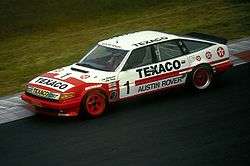
- Steve Soper and René Metge won the 1983 RAC Tourist Trophy driving a Rover Vitesse
- Andy Rouse won the 1984 British Saloon Car Championship driving a Rover Vitesse.
- Jeff Allam and Armin Hahne won the Group A class and finished 12th outright at the 1984 Bathurst 1000 in a Tom Walkinshaw Racing (TWR) Rover Vitesse.
- Tom Walkinshaw and Win Percy won six rounds (Monza, Vallelunga, Donington, Silverstone, Nogaro and Jarama) of the 1985 European Touring Car Championship driving a TWR Rover Vitesse.[19]
- TWR Rovers won five rounds (Monza, Donington, Anderstorp, Zeltweg and Silverstone) of the 1986 FIA Touring Car Championship.
- Kurt Thiim won the 1986 DTM cahmpionship driving a Rover Vitesse.
In touring car racing, the 3.5 L Rover V8 engine produced approximately 340 bhp (254 kW; 345 PS) by 1986.
British police use
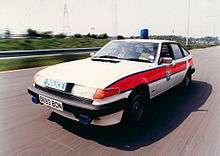
The SD1 was popular with British police forces, particularly in V8 form. West Yorkshire Police were the first police force to use the SD1. When SD1 production was ceasing, police forces stockpiled a number of the cars for later use, to be introduced over the late 1980s.[20] On 8 May 1987 a pair of Metropolitan Police SD1s made the now famous "Liver Run", transporting a donor organ from the M11 to the Cromwell Hospital West London, covering 27 miles in under 30 minutes. The run was part of a Police Camera Action special broadcast in 1997, including the patient who successfully survived the transplant.[21]
References
Citations
- ↑ The New Zealand Market Retrieved from http://roversd1australia.com/ on 28 December 2015
- ↑ "Rewind to 1977: Rover 3500.". Quicks. Retrieved 23 January 2014.
- ↑ Top Gear, Series 4 Episode 8 18 July 2004
- ↑ Hogg, Tony (ed.). "Rover 3500: Rover, Rover, now you can come over". Road & Track's Road Test Annual & Buyer's Guide 1981 (January–February 1981): 160.
- ↑ Hutton, Ray, ed. (19 March 1977). "Rovers in Europe – with what? Opportunities aplenty – but no cars". Autocar: 14.
- ↑ Hutton, Ray, ed. (11 June 1977). "News: The Midlander of the Year Award....". Autocar. 146 (4205): 18.
- 1 2 Bell, Roger, ed. (22 January 1977). "Motor Road Test: Rover 3500 auto". Motor: 4–7.
- ↑ Mays, Raymond (19 March 1977). "The best car I've ever had". Autocar: 48–49.
- 1 2 Vicar, Archie (July 1980). "Roverpowering". Today's Motoring Magazine: 45–46.
- ↑ Åkesson Broberg, Kjell; Swedeborn, Staffan (June 1983). "Bilguiden Rover SD1: Lyx till lågpris" [Car guide Rover SD1: Low-priced luxury]. Automobil (in Swedish). No. 5. Vällingby: Paper Maker AB. p. 50. ISSN 0280-1981.
- ↑ Hogg, Tony (ed.). "1981 Buyer's Guide". Road & Track's Road Test Annual & Buyer's Guide 1981 (January–February 1981): 116.
- ↑ Pender (1998), p. 153.
- ↑ Winters, Rene. "Rover 3500 sedan makes U.S. debut in 1980". The World of the Rover SD1. Retrieved 6 August 2013.
- ↑ Flammang, James M. (1994). Standard Catalog of Imported Cars, 1946–1990. Krause Publications. p. 553. ISBN 0-87341-158-7.
- ↑ Pender (1998), p. 154.
- ↑ Turner, Rob; Cope, Tony (1987). "The Rover SD1 in Australia – 1978 to 1987". Freeheeling. The Rover Owner's Club.
- ↑ Rover, Rover, now you can come over, p. 159
- ↑ Pender (1998), p. 155.
- ↑ 1985 European Touring Car Championship, touringcarracing.net Retrieved on 9 December 2014
- ↑ Top Gear, Series 4 Episode 8 18 July 2004 Hammond: The police loved the SD1 so much, that when they heard it was going out of production in 1986, they stockpiled cars, so they could use them after they died off.
- ↑ http://www.ukemergency.co.uk/the-liver-run/
Bibliography
- Pender, Karen (1998). Rover SD1: The Complete Story. Crowood Books. ISBN 1-86126-111-X.
External links
| Wikimedia Commons has media related to Rover SD1. |